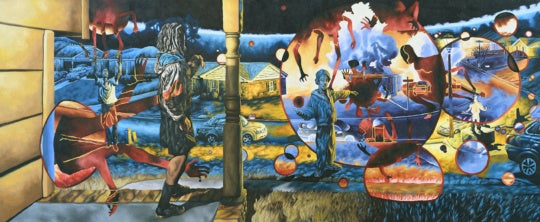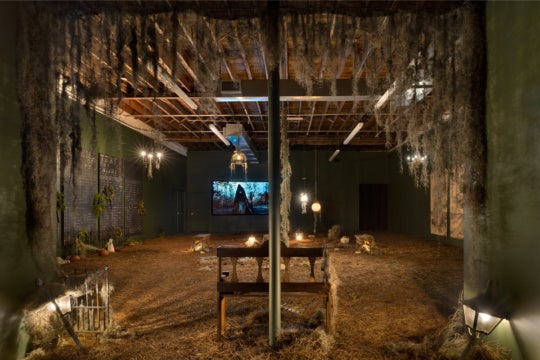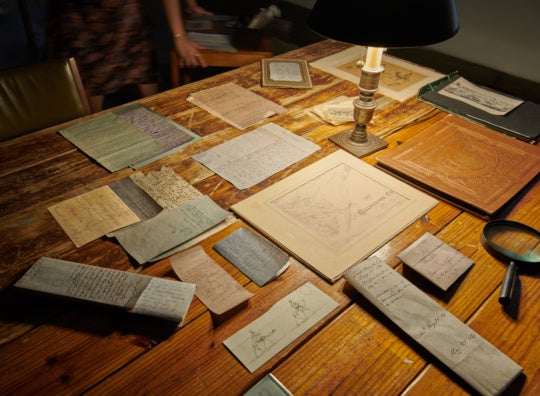Talking Heads is a monthly column that presents conversations utilizing a casual online interface in order to engage in critical subject matter.
Stuart Horodner, artistic director of the Atlanta Contemporary Art Center, and Craig Drennen have an early morning chat about their recent trips to New York during the Armory fair week, where Horodner sat on an Armory Open Forum panel, The Question of Regionalism, moderated by Isolde Brielmaeir.
Stuart Horodner <–> Craig Drennen
03/23/13
7:15 AM
Craig Drennen: Good morning, sir. Have you digested your NYC art fair experience yet?
7:17 AM
Stuart Horodner: I had a dream this morning that Woody Allen was running a bookstore in NY and he’d made a sculpture that was an old computer printer spitting out an seemingly endless loop of paper. Kind of like the early Charles Ray, the line of ink falling from ceiling to floor.
7:17 AM
CD: Sounds like a nightmare.
7:18 AM
SH: I was trying to convince him to do an interview about art and literature. So Mr. Timon of Athens….
7:19 AM
CD: Please make that happen! Which fairs did you end up seeing?
7:20 AM
SH: They are always hard to digest. Many impressions. I went to Armory because I was on a panel about regionalism. So I saw that one and the Independent fair.
7:21 AM
CD: The Armory fair was the one I went up to see. And after the dust settled I still think it was the best one. I liked the “Focus” portion of the Armory that was directed by curator selections.
7:24 AM
SH: It’s funny, we always see it but also hear buzz about it. This year I read and heard much about how the Armory was doing under pressure from Frieze. I enjoyed roaming the aisles and grazing visually. What stopped me…Rochelle Feinstein at On Stellar Rays/Higher Pictures, your dealer at Samsøn with his Richard Pryor-related booth, and a brand new painting by Karl Wirsum at Derek Eller.

7:26 AM
CD: That was Todd Pavlisko at Samsøn and they looked strong! And Rochelle Feinstein always looks strong as well. I was really pleased with the Pierogi booth as well—those Ward Shelly pieces were great. And the Jim Torok drawings of the Dorian Gray seemed very timely.
I went to the first Pierogi 2000 shows back in the early ’90’s, so every time I see Joe and the Pierogi team I feel proud.

7:30 AM
SH: I always enjoy talking with you about “old” NY. Scenes there change so much over time, SoHo, East Village, Chelsea, now Lower East Side. I appreciate that you have that history there. We can speak the language of Fanelli’s Bar and treking out to Brooklyn.
7:32 AM
CD: All true. You might not know this but I worked for Clarissa Dalrymple at the very first Gramercy Art Fair back in the day–maybe ’94 or ’95? So I always like to look at how the fairs have evolved.
I like that Armory and Frieze both try to add something that’s not only about the marketplace. And I thought the Dutch galleries looked good at the Armory as well. Gallerie Van Gelder was very good, for instance….
7:38 AM
SH: Ah, funny story. If you went to the 1993 show at the New Museum, you probably saw the installation on the ground floor by Devon Dikou. Her piece contained documentation of the project my gallery did with Saul Ostrow at the Roger Smith Hotel, called Transient décor—a suite of hotel rooms emptied out and replaced with art—sheets by Polly Apfelbaum, furniture by architects LOT-EK, cracked mirrors by Curtis Mitchell, etc. Well everyone came to that, Pat Hearn and Colin de Land and Paul Morris who started Gramercy the next year or so. So I feel like I have some weird part in it all.
I’m always interested in the rub between commercial and not. How do you take advantage of being a presenter at a fair? What do you do? Matthew Higgs at White Columns always had a good approach about this.
7:39 AM
CD: Yes, I did see that at the New Museum. And I took a picture of the signboard with your name on it and forwarded it to you. To which, sir, you did not respond. (Apology accepted.)

7:40 AM
SH: Ha. I’ll search my phone. I usually prioritize messages from you.
7:40 AM
CD: But yes, Higgs and White Columns have adopted a great position at the fairs.
I even trudged over to the Spring Break show on Mott Street (I think) because people told me that show was young and scrappy. But I’m not sure it lived up to its promise this time around. Spring Break wasn’t an art fair exactly, but whatever…
7:44 AM
SH: So how about Independent, where Matthew was…Do you like that fair, at the former DIA building? I am often haunted by the feeling as I walk around there—memories of Ann Hamilton and Diane Thater shows in the place where I’m standing and talking to Joel Dictrow, who is one of my favorite NY collectors.
And talking is something we should talk about. Seeing goes along with constant yapping at the fairs.
7:45 AM
CD: I stepped into the Independent, but didn’t do it justice. The conversation does amp up during art fair season.
7:46 AM
SH: I like Independent. Most of my best viewing experiences at fairs, museums, and galleries, have to do with scale. Focus. I like the layout of Independent, and honestly, the presenters there are more risky with what they show and how they show it. So I feel an affinity with them.
7:49 AM
CD: The willingness to take risk at an art fair seems important. And it really stands out—who’s playing it safe and who is willing to take a risk. Were there any Atlanta galleries in NYC this time? I liked seeing the Atlanta presence in Miami this past go around.
Could you expand on what you mean by “risk” though?
7:51 AM
SH: I don’t recall any ATL galleries at the NY fairs. It is good seeing them have a presence at Miami, and so many artists and critics from our city going down there. So, why do you go to the fairs and galleries—which I know you do actively. What do you get out of it?
I will comment on risk after you answer.
And any good shows you saw? I have a few to mention.
7:52 AM
CD: Well, the fairs serve a twofold purpose for me, maybe more. Part of it is just social. It’s the one place where I can reconnect with friends and artists from all the phases of the life. I see Skowhegan alums, old Guggenheim co-workers, former students, gallery mates, curators, etc. It’s one of the only times all those people are in one place.
And the other part is just to get a snapshot of what’s going on. That’s especially true since I moved to Atlanta.
7:58 AM
SH: I totally agree. When people use the word “art community,” that is where I feel it. I know it is a global industry, and some parts of it don’t really enter into my day to day that often (auctions for example), but seeing colleagues and friends and comparing notes and feeling one’s part of it is great. You/we/others have to be out and looking and talking, arguing. Did you see the Al Held show at Cheim & Reid?
And I know we have a connected ATL community too. The flow from one to another is crucial.
7:58 AM
CD: Yes, sir. The Al Held show opened my eyes to Held again. And the Paul Laffoley show at Kent was great. And the Jeff Elrod show at Journal Gallery in Brooklyn was outstanding. I always follow the viewing suggestions of my friend Tatiana Berg. She seems to know where the interesting paintings shows are.
And the Wendy White paintings at Koenig’s booth were really great.
8:04 AM
SH: You did get around. OK, so risk. Sometimes risk is putting layers and layers of intense yellow acrylic on canvas! That presence of color in Held’s was intense! Wendy White is someone we’ve shown at ACAC and she is always pushing her ideas about painting. Sometimes risk is showing one killer piece in a giant space, maybe something tiny. Breaking one’s habits and expectations. I think I just enjoy being surprised by artists, dealers, and writers. And I try to do this with my curating and programming.

8:05 AM
CD: Nicely put.
8:05 AM
SH: Surprise folks, I mean. And myself. Challenge the way I usually do it. Have been thinking of that more these days.
8:08 AM
CD: That seems like a good final point. The Gutai show at the Guggenheim revealed a lot about risk, I think.
8:09am
SH: I agree. The Gutai work should be better known by folks. It is startling how free those artists felt. I think this is the end…I’m going for a massage in 50 minutes.
8:10 AM
CD: And yet—if I may say so—a lot of the Gutai work now seems dated. The Atsuko Tanaka light dress was one of the few pieces that still seemed like it was relevant to the current moment.
Yes, go to your massage!




